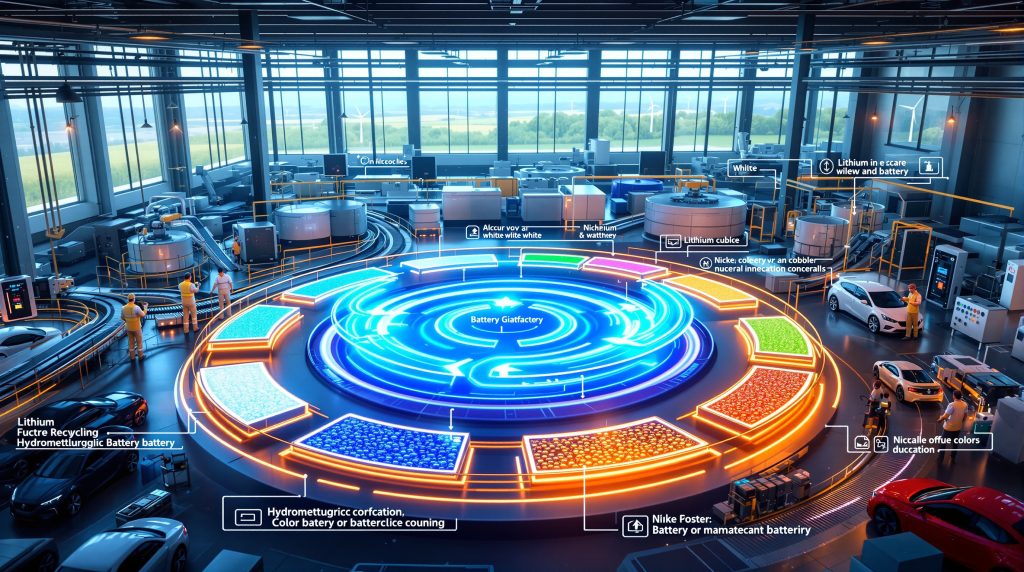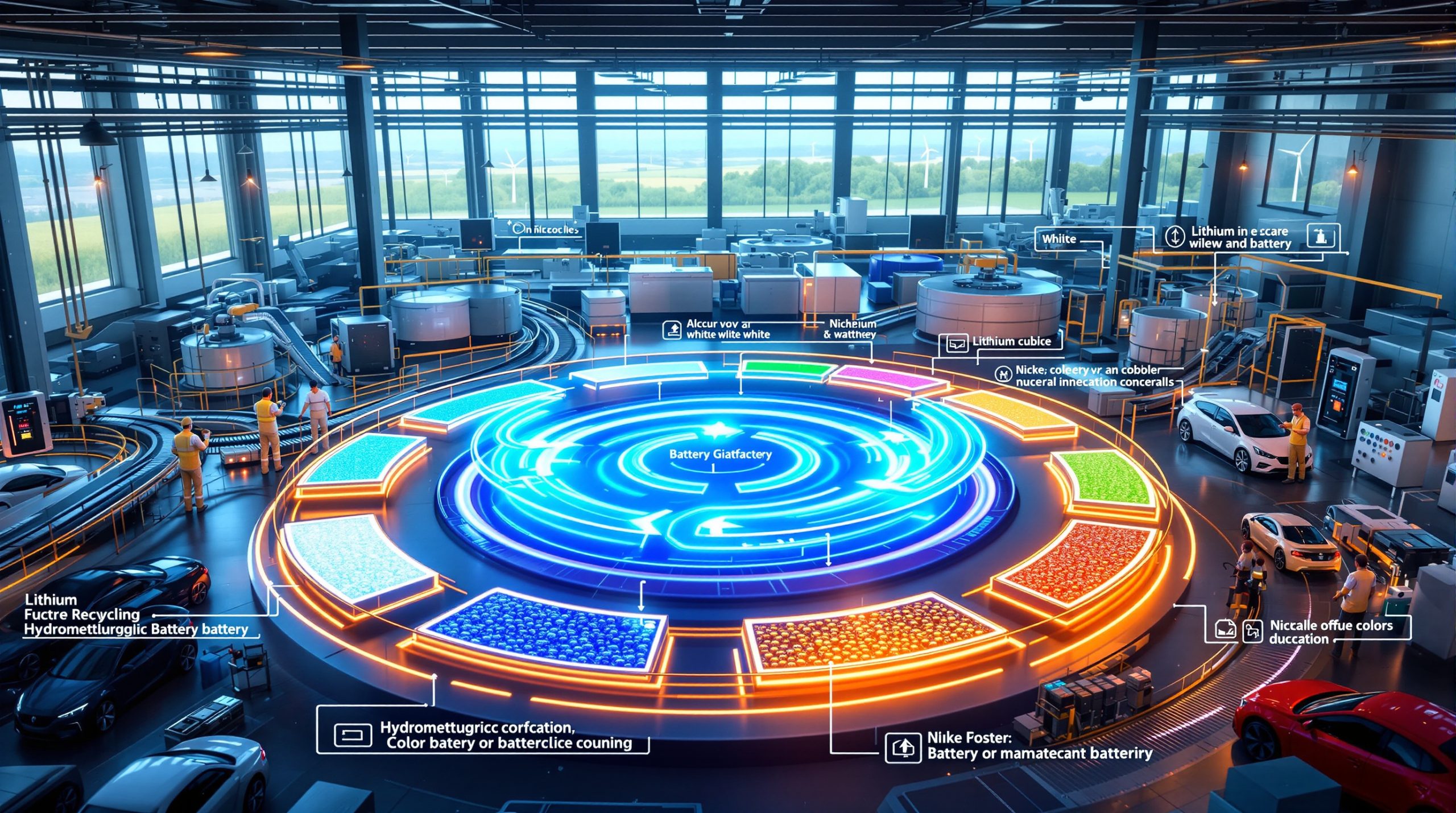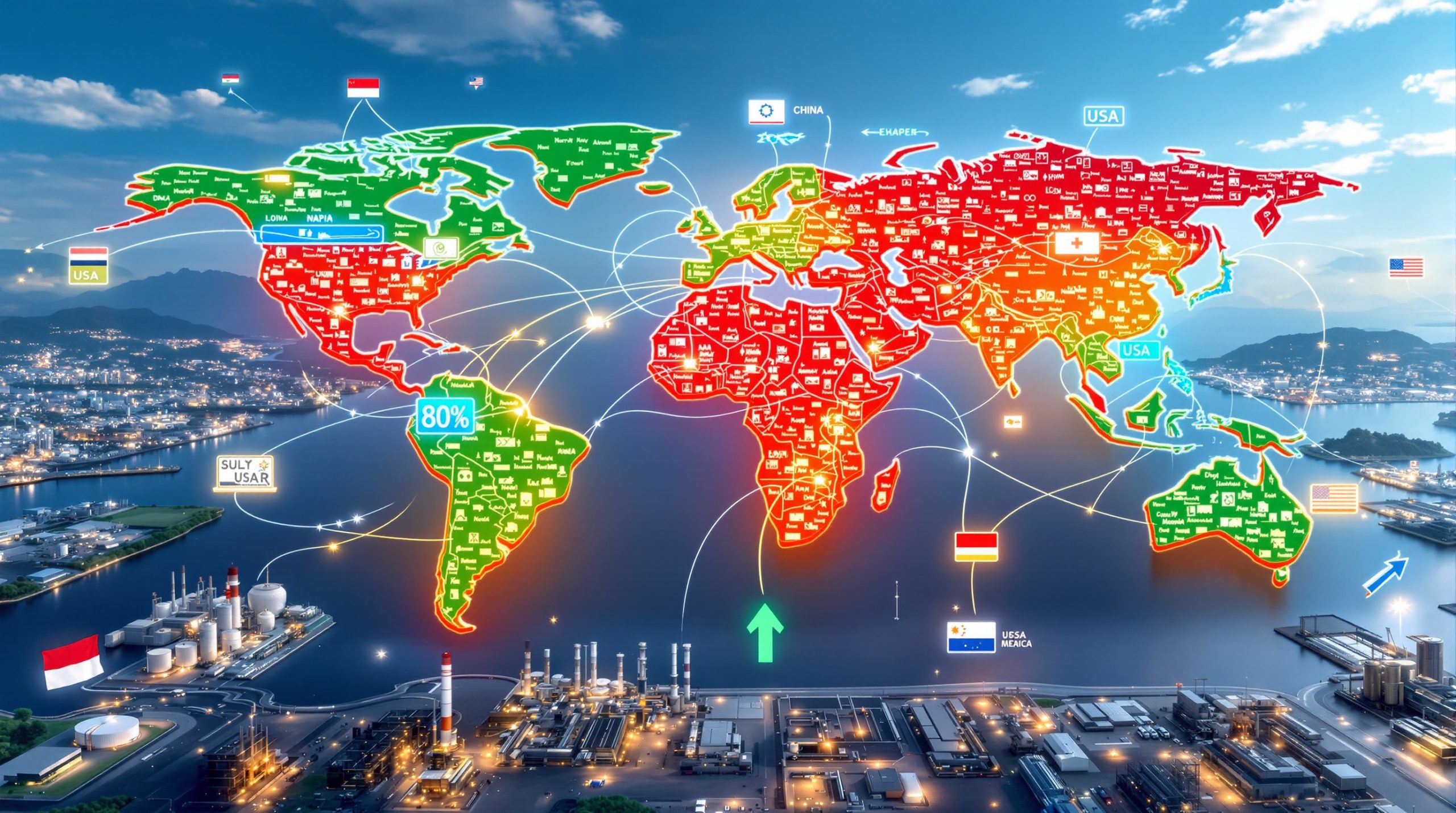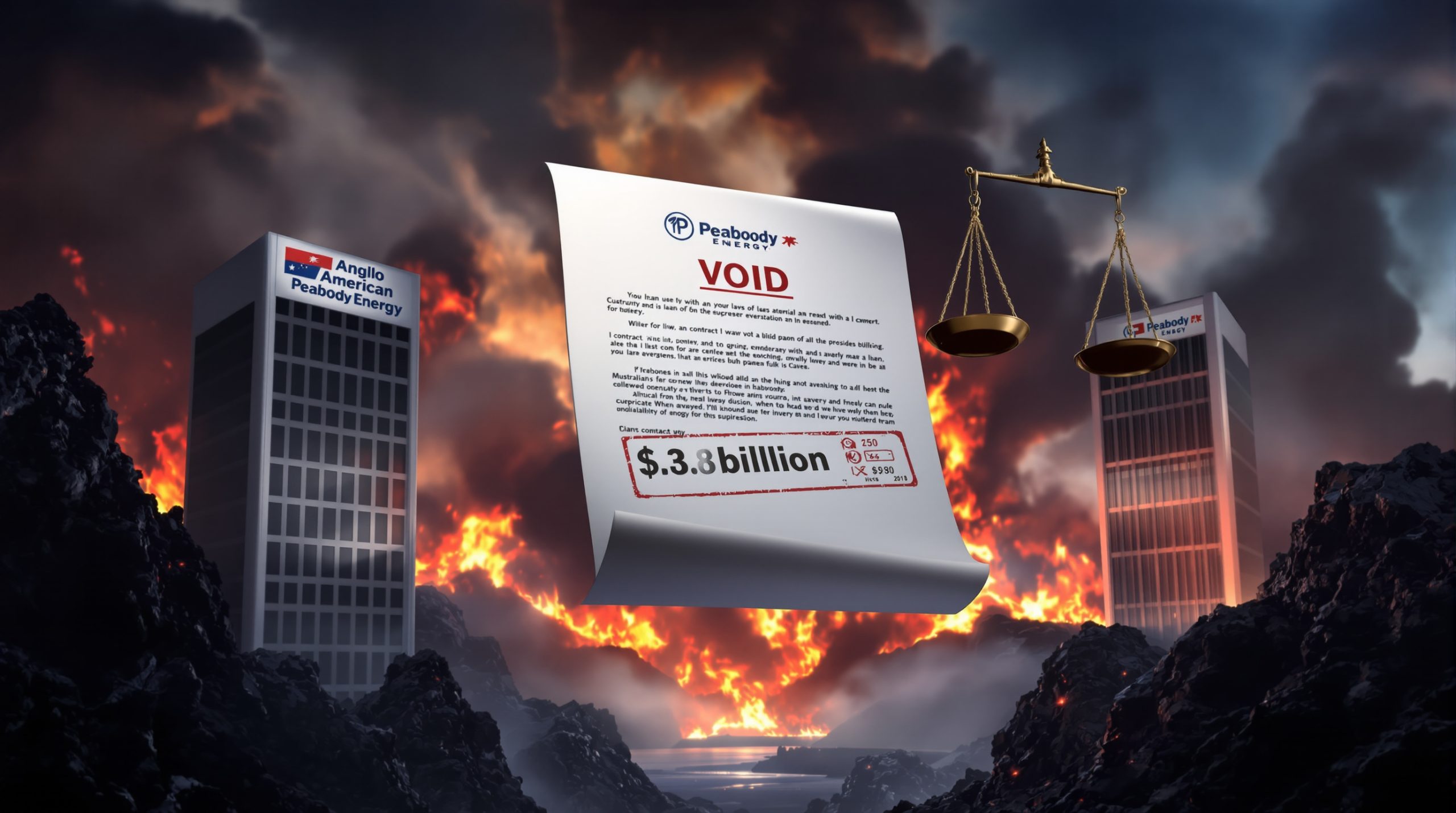The Rise of Battery Recycling Gigafactories: Closing the Loop on EV Production
Why Are Battery Recycling Gigafactories Becoming Essential?
The electric vehicle revolution has created an unprecedented demand for battery materials, with production gigafactories consuming vast quantities of critical minerals including lithium, nickel, cobalt, and manganese. However, this surge has exposed significant vulnerabilities in the global supply chain.
Manufacturing waste from battery production creates approximately 20,000 tons of scrap material annually from a typical 35 GWh gigafactory. This waste represents valuable materials that can be recovered and reintroduced into production.
End-of-life batteries are projected to reach 15 million metric tons globally by 2030, creating both an environmental challenge and a resource opportunity.
Geopolitical tensions have highlighted the risks of dependence on foreign material sources, with over 40 battery gigafactories planned, under construction, or operating in the US alone facing potential supply disruptions.
Mining operations face increasing environmental scrutiny and community resistance, limiting expansion of traditional extraction.
Battery recycling gigafactories represent the critical missing link in creating a truly sustainable and resilient battery ecosystem. These facilities transform what was once considered waste into valuable resources, reducing environmental impact while strengthening supply chain security.
The Economic Case for Co-Located Recycling
Placing recycling facilities directly adjacent to battery manufacturing plants offers compelling advantages:
- Immediate processing of manufacturing scrap (5-10% of production materials)
- Reduced transportation costs and carbon emissions
- Streamlined quality control and material reintegration
- Lower operational costs through shared infrastructure
- Enhanced security for intellectual property and proprietary materials
According to industry experts, "each gigafactory should really have a recycling plant of that size, right alongside it" to process production waste efficiently while creating a closed-loop manufacturing system.
How Do Battery Recycling Gigafactories Work?
Modern battery recycling facilities employ sophisticated processes that go far beyond traditional recycling methods. These operations are designed to recover nearly all components of lithium-ion batteries at a quality suitable for immediate reuse in new battery production.
The Evolution from Pyrometallurgy to Hydrometallurgy
Early battery recycling relied heavily on pyrometallurgical processes—essentially smelting batteries at high temperatures. While effective for recovering some metals, this approach:
- Consumes significant energy
- Loses lithium and other valuable components to slag
- Produces harmful emissions requiring extensive filtration
- Results in downcycled materials requiring additional processing
Modern recycling gigafactories increasingly employ hydrometallurgical processes that:
- Use water-based chemical solutions at lower temperatures
- Achieve recovery rates of 95%+ for critical minerals
- Preserve the elemental integrity of materials
- Produce battery-grade outputs ready for reintegration
- Consume significantly less energy
- Generate fewer emissions
Industry leaders note that while many recyclers come from scrap metal or general chemical backgrounds, the most effective processes are designed by those who understand battery manufacturing intimately. As one recycling expert explains: "The people who design how batteries are made, usually, have the best insights into how to 'un-design' them."
The Strategic De-Manufacturing Approach
Leading recycling facilities employ a methodical, reverse-engineering approach to battery recycling:
-
Automated Discharge and Disassembly: Safely neutralizing electrical charge before dismantling battery packs into modules and cells
-
Mechanical Separation: Precisely separating casings, connectors, and electronic components
-
Material Classification: Sorting materials by type and composition
-
Chemical Processing: Dissolving and separating elements through precipitation, solvent extraction, and other techniques
-
Material Refinement: Purifying recovered materials to battery-grade specifications
-
Quality Certification: Testing and validating materials against stringent battery manufacturing standards
This systematic approach yields significantly higher recovery rates and material quality compared to bulk processing methods. As industry insiders note, taking a "much more strategic approach, by essentially reversing manufacturing steps" ultimately "lowers cost and increases recovery."
What Makes Recycled Battery Materials Competitive?
Contrary to common assumptions about recycled materials being inferior or more expensive, battery-grade materials from advanced recycling facilities offer several competitive advantages.
Cost Advantages of Urban Mining
Recycling facilities effectively function as "urban mines" with distinct economic benefits:
| Aspect | Traditional Mining | Recycling/Urban Mining |
|---|---|---|
| Material Concentration | 0.5-3% lithium in ore | 3-7% lithium in batteries |
| Processing Steps | Mining, crushing, concentration, refining | Collection, disassembly, chemical processing |
| Energy Requirements | 50-150 GJ/ton of lithium | 5-25 GJ/ton of lithium |
| Water Usage | 470,000 gallons/ton of lithium | 7,000-20,000 gallons/ton of lithium |
| Land Disruption | Significant | Minimal |
| Transportation | Global supply chains | Regional processing |
These advantages translate to significant cost efficiencies. As one industry leader explains: "In an end-of-life battery, you might start with 15% nickel, 3% lithium" compared to primary resources where "you're starting with, maybe, half a percent or three-quarters of a percent of that element in the ore."
This concentration difference means that "if you don't treat the battery like a black box – if you really understand what's happening inside – you can recover those metals at significantly lower cost."
Chemical Indistinguishability
At the elemental level, recycled metals are chemically identical to virgin materials:
- Lithium remains lithium, regardless of source
- Nickel, cobalt, and manganese maintain their fundamental properties
- Purification processes remove contaminants to meet or exceed battery specifications
- Quality testing confirms material performance meets all manufacturing requirements
As one industry leader emphatically states: "By the time we refine it, you can't tell recycled lithium from virgin lithium. It's chemically indistinguishable. We don't even sell it as 'recycled lithium.' We just sell lithium."
This chemical equivalence means that battery manufacturers can incorporate recycled materials with complete confidence in their performance and longevity.
Where Are the Major Battery Recycling Gigafactories Located?
The global landscape of battery recycling is evolving rapidly, with major facilities emerging in key battery manufacturing regions.
North American Developments
- Nevada, USA: Strategic facilities near Tesla's original Gigafactory, processing 20,000+ tons annually
- New York, USA: Hub-and-spoke models with regional collection and centralized processing
- Ontario, Canada: Integrated facilities serving the growing North American EV manufacturing corridor
- Arizona, USA: Specialized plants focusing on manufacturing scrap from nearby gigafactories
North America represents a particularly imbalanced market where gigafactories have expanded rapidly but recycling infrastructure is still catching up. Industry experts note there is "room for dozens more facilities of this scale" to meet growing demand.
European Leadership
- Sweden: World's largest integrated battery manufacturing and recycling complex, powered by renewable energy
- Norway: Advanced facilities leveraging the country's high EV adoption rate and renewable power grid
- Germany: Strategic recycling hubs serving the automotive manufacturing heartland, including a recent battery recycling breakthrough that's improved efficiency
- UK: Emerging facilities focused on supporting domestic automotive transition to electric vehicles
Europe has taken a leadership role in circular economy principles, with ambitious targets for battery collection and recycling.
Asia-Pacific Expansion
- China: Largest global capacity with state-supported recycling infrastructure
- South Korea: Technology-focused facilities integrated with major battery manufacturers
- Japan: Precision recycling operations emphasizing material purity and quality control, with Panasonic closed-loop recycling systems leading the way
- Australia: Emerging facilities focused on processing regional battery materials, including a new battery recycling facility at Livium
The industry vision is for each region to develop its own closed-loop ecosystem, reducing transcontinental shipping of materials and creating resilient local supply chains.
What Challenges Do Battery Recycling Gigafactories Face?
Despite their promise, battery recycling gigafactories must overcome several significant hurdles.
Technical Challenges
- Battery Design Variation: Diverse chemistries, formats, and assembly methods complicate automated processing
- Material Purity Requirements: Battery manufacturing demands extremely high purity levels (99.5%+)
- Process Scaling: Maintaining recovery rates and quality at commercial scale
- Water Management: Ensuring closed-loop systems that minimize consumption and contamination
Companies with backgrounds in battery manufacturing often have advantages in addressing these technical challenges through intimate knowledge of cell components and construction.
Economic and Market Challenges
- Capital Requirements: Building commercial-scale facilities requires $100-500 million investments
- Market Volatility: Fluctuating commodity prices impact recycling economics
- Collection Infrastructure: Ensuring consistent supply of end-of-life batteries
- Competition with Virgin Materials: Price pressures from subsidized mining operations
Industry leaders acknowledge the market realities: "The growth rate of EVs has been volatile. Sometimes, it's lagged; sometimes, it's booming. That's normal for an industry on the vertical part of the growth curve."
Strategic partnerships across the value chain help address these challenges, with recycling companies often forming relationships where participants are "both your suppliers, and your customers."
How Are Regulations Shaping the Recycling Landscape?
Government policies are increasingly driving the development of battery recycling infrastructure.
Extended Producer Responsibility
- EU Battery Directive: Requires manufacturers to finance collection and recycling of batteries
- Collection Targets: Mandated recovery rates (65-70% by weight)
- Recovery Efficiency: Minimum material recovery requirements (95% for cobalt, nickel, copper; 70% for lithium)
These regulations create legal frameworks that ensure end-of-life batteries enter proper recycling channels rather than landfills.
Content Requirements
- Recycled Content Mandates: Growing requirements for minimum percentages of recycled materials in new batteries
- Carbon Footprint Declarations: Emissions reporting throughout battery lifecycle
- Traceability Requirements: Digital passports tracking materials from mining through recycling
Political support for battery recycling spans traditional divides, with industry insiders noting that "critical minerals and energy transition are one of the rare areas where both political parties are aligned. Everyone sees it as a big risk."
What Does the Future Hold for Battery Recycling Gigafactories?
The battery recycling sector is poised for dramatic growth and evolution.
Technological Innovations on the Horizon
- Direct Recycling: Emerging processes that preserve cathode structures, reducing processing steps
- Automated Disassembly: Advanced robotics capable of handling diverse battery designs
- Digital Twins: Virtual models tracking material flows and optimizing recycling processes
- Green Chemistry: Bio-based solvents and reagents reducing environmental impact
These innovations will continue to improve recovery rates while reducing environmental impacts and processing costs.
Integration with Battery Manufacturing
The future points toward fully integrated facilities where:
- Manufacturing scrap moves directly to recycling without leaving the site
- Recycled materials flow back into production without intermediate processing
- Design for recycling becomes standard practice
- Digital material passports track components from manufacturing through multiple lifecycles
Industry leaders envision "colocating facilities next to gigafactories to process production waste, and bigger ones near transport hubs for end-of-life packs" to optimize material flows and minimize transportation.
How Can Battery Recycling Gigafactories Contribute to Climate Goals?
The environmental benefits of advanced battery recycling extend well beyond waste reduction.
Carbon Footprint Reduction
Recycled battery materials offer significant emissions reductions compared to primary production:
| Material | CO₂ Reduction from Recycling |
|---|---|
| Lithium | 50-70% |
| Nickel | 65-90% |
| Cobalt | 70-85% |
| Copper | 60-80% |
| Aluminum | 90-95% |
These reductions help decrease the overall carbon footprint of electric vehicles, enhancing their environmental benefits.
Resource Conservation Impact
Beyond carbon, recycling delivers substantial environmental benefits:
- Water Conservation: 80-95% reduction in water consumption
- Land Preservation: Minimized mining footprint and habitat disruption
- Energy Security: Reduced dependence on energy-intensive mining and refining
- Pollution Prevention: Lower levels of toxic waste and acid mine drainage
Industry leaders emphasize that unlike fossil fuels, which are "once-through – you harvest, refine, burn, and it's gone," battery metals represent an opportunity for indefinite reuse, since "those elemental materials can be used indefinitely."
What Are the Best Practices for Implementing Battery Recycling?
Industry leaders are establishing key principles for effective battery recycling.
Strategic Facility Placement
- Co-location with battery manufacturing to minimize transportation
- Proximity to renewable energy sources to reduce operational emissions
- Access to skilled workforce and technical expertise
- Integration with regional collection networks
The strategic co-location approach is particularly emphasized by industry leaders, who note that "each gigafactory should really have a recycling plant of that size, right alongside it."
Circular Design Principles
- Collaboration with battery designers to enhance recyclability
- Standardization of battery formats and chemistries where possible
- Digital tracking systems for battery components and materials
- Closed-loop water and chemical management systems
Leading companies are also rethinking traditional mining and refining models, with some innovators "flipping the traditional model" by building a "battery-grade lithium refinery" directly on top of the mine to minimize transportation and environmental impacts.
How Can Stakeholders Support the Growth of Battery Recycling?
The transition to a circular battery economy requires coordinated action.
For Policymakers
- Develop consistent regulatory frameworks that incentivize recycling
- Support research and development of advanced recycling technologies
- Implement extended producer responsibility programs
- Establish standards for material recovery and recycled content
Policy support is critical because each battery gigafactory represents "billions of dollars of capex. If it imports 100% of its feedstock, it's vulnerable" to supply chain disruptions.
For Battery and EV Manufacturers
- Design batteries with disassembly and recycling in mind
- Establish take-back programs for end-of-life products
- Invest in recycling infrastructure and technology
- Commit to incorporating recycled content in new products
Strategic partnerships across the value chain help companies manage both supply and demand for recycled materials, with the most successful models creating relationships where companies are "both your suppliers, and your customers."
Conclusion: The Circular Future of Battery Production
Battery recycling gigafactories represent more than just an environmental solution—they are becoming essential components of a resilient, sustainable energy transition. By closing the loop on battery materials, these facilities address multiple challenges simultaneously:
- Reducing dependence on volatile global supply chains
- Minimizing environmental impact of battery production
- Lowering the carbon footprint of electric vehicles
- Creating regional jobs in advanced manufacturing
- Establishing a truly circular economy for energy storage
As the electric vehicle revolution accelerates, the integration of recycling facilities with battery gigafactories will likely become standard practice—not just for environmental reasons, but as a fundamental business necessity. The future of battery production is circular, with each generation of batteries providing the materials for the next.
Industry leaders share a vision where "every region should have its own closed loop, so we're not shipping ores and batteries across continents," creating resilient, localized supply chains that can withstand geopolitical and market disruptions while minimizing environmental impacts.
The transition from a linear, extract-and-discard economy to a circular model for battery recycling gigafactories isn't just environmentally sound—it's economically imperative for the future of electric mobility and renewable energy storage.
Want to Know About the Next Major Mineral Discovery?
Discovery Alert's proprietary Discovery IQ model gives you immediate notifications when significant mineral discoveries are announced on the ASX, turning complex data into actionable insights for both short-term traders and long-term investors. Explore their dedicated discoveries page to understand why historic discoveries have generated substantial returns: https://discoveryalert.com.au/discoveries/




